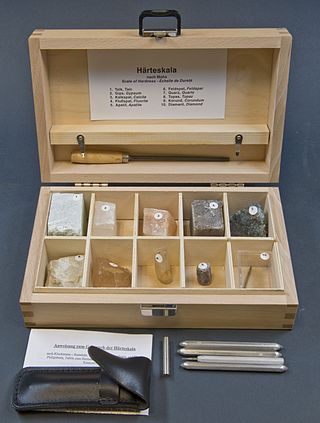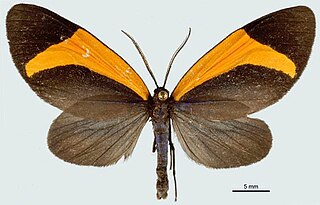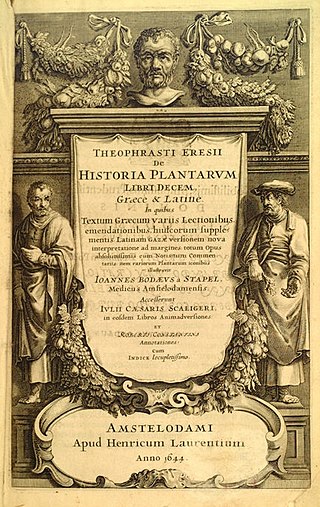Character or Characters may refer to:

The Mohs scale of mineral hardness is a qualitative ordinal scale, from 1 to 10, characterizing scratch resistance of minerals through the ability of harder material to scratch softer material.

Theophrastus was a Greek philosopher and the successor to Aristotle in the Peripatetic school. He was a native of Eresos in Lesbos. His given name was Τύρταμος (Túrtamos); his nickname Θεόφραστος (Theóphrastos) was given by Aristotle, his teacher, for his "divine style of expression".
The Peripatetic school was a philosophical school founded in 335 BC by Aristotle in the Lyceum in Ancient Athens. It was an informal institution whose members conducted philosophical and scientific inquiries. After the middle of the 3rd century BC, the school fell into decline, and it was not until the Roman Empire that there was a revival.
Metrocles was a Cynic philosopher from Maroneia. He studied in Aristotle’s Lyceum under Theophrastus, and eventually became a follower of Crates of Thebes, who married Metrocles’ sister Hipparchia. Very little survives of his writings, but he is important as one of the first Cynics to adopt the practice of writing moral anecdotes (chreiai) about Diogenes and other Cynics.

Eudemus of Rhodes was an ancient Greek philosopher, considered the first historian of science, who lived from c. 370 BCE until c. 300 BCE. He was one of Aristotle's most important pupils, editing his teacher's work and making it more easily accessible. Eudemus' nephew, Pasicles, was also credited with editing Aristotle's works.

Crocomela is a genus of moths in the subfamily Arctiinae. The genus was described by William Forsell Kirby in 1892.

Crocomela flammifera is a moth of the subfamily Arctiinae first described by William Warren in 1904. It is found in Peru.

Aphroditus or Aphroditos was a male Aphrodite originating from Amathus on the island of Cyprus and celebrated in Athens.

Olea oleaster, the wild-olive, has been considered by various botanists a valid species and a subspecies of the cultivated olive tree, Olea europea, which is a tree of multiple origins that was domesticated, it now appears, at various places during the fourth and third millennia BCE, in selections drawn from varying local populations. The wild-olive, which ancient Greeks distinguished from the cultivated olive tree, was used to fashion the olive wreath awarded victors at the ancient Olympic games. The ancient and sacred wild-olive tree of Olympia stood near the Temple of Zeus, patron of the games.

The Pericopina is a subtribe of tiger moths in the family Erebidae. The subtribe was described by Francis Walker in 1869.
Crocomela albolineata is a moth of the subfamily Arctiinae. It was described by Herbert Druce in 1911. It is found in Colombia and northern Ecuador.
Crocomela colorata is a moth of the subfamily Arctiinae. It was described by Francis Walker in 1865. It is found in Colombia and Peru.
Crocomela fusifera is a moth of the subfamily Arctiinae. It was described by Francis Walker in 1856. It is found in Colombia.
Crocomela inca is a moth of the subfamily Arctiinae. It was described by Schaus in 1892. It is found in Peru and Bolivia.
Crocomela intensa is a moth of the subfamily Arctiinae. It was described by Francis Walker in 1854. It is found in Venezuela.
Crocomela luxuriosa is a moth of the subfamily Arctiinae. It was described by Hering in 1925. It is found in Colombia.
Crocomela tenuifascia is a moth of the subfamily Arctiinae. It was described by Hering in 1925. It is found in Ecuador.
Crocomela tripunctata is a moth of the subfamily Arctiinae. It was described by Herbert Druce in 1885. It is found in Ecuador.

Theophrastus's Enquiry into Plants or Historia Plantarum was, along with his mentor Aristotle's History of Animals, Pliny the Elder's Natural History and Dioscorides's De materia medica, one of the most important books of natural history written in ancient times, and like them it was influential in the Renaissance. Theophrastus looks at plant structure, reproduction and growth; the varieties of plant around the world; wood; wild and cultivated plants; and their uses. Book 9 in particular, on the medicinal uses of plants, is one of the first herbals, describing juices, gums and resins extracted from plants, and how to gather them.








